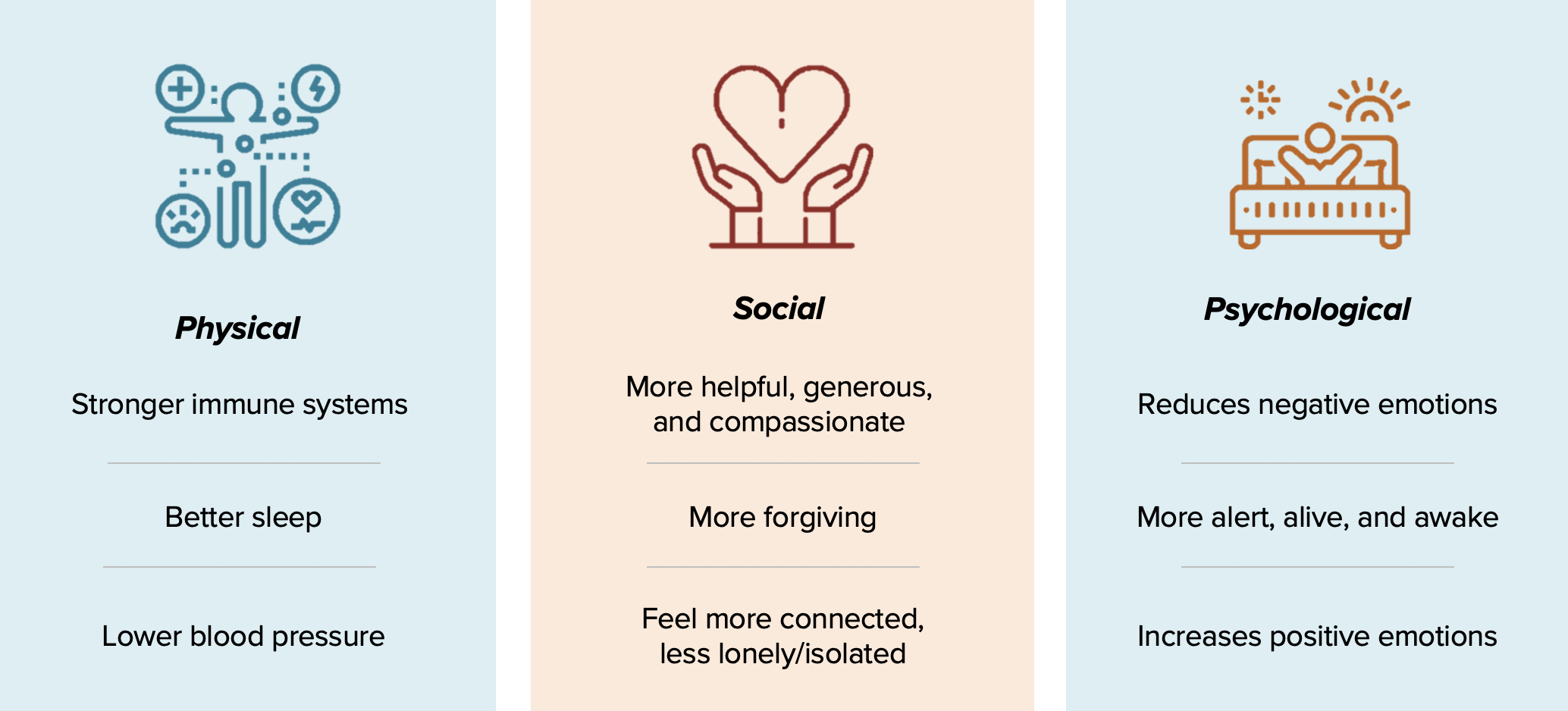The Power of Leading With Gratitude
As we come to the close of a challenging year, it’s appropriate to recognize the important role that gratitude can play in our lives and the places we work. Leaders, in particular, can harness the power of gratitude to create better places to work, no matter what is happening in the world around us.
The What and Who of Gratitude
Gratitude, according to Robert Emmons, a leading researcher on the subject, is a state of thankfulness when we acknowledge the good in the world (the what), and connect that goodness to a source outside of ourselves (the who).
The what of gratitude can include experiences, realities, things or people that bring us joy and make our lives more meaningful. The who refers to the source or enabler of those good things. This can be a person, an organization, a system, or (if it aligns with your beliefs) a higher power.
Two quick caveats: first, there are certainly good things in our lives that are related to ourselves. For example, you may feel grateful for having a good work ethic and the ability to make money, but chances are someone modeled that trait for you. Or, perhaps somewhere along the way, you had a teacher, mentor, or manager who helped you develop the skill set you currently use to make a living. Secondly, it’s important to remember that being grateful does not mean we don’t experience hardship and sadness. Both are realities in life. Gratitude is simply pausing to recognize the good moments and experiences along the way.
The Physical, Psychological, and Social Effects of Gratitude
Gratitude comes with a plethora of positive physical, psychological, and social effects. When we experience gratitude, our brains release dopamine and serotonin, two important neurotransmitters that are responsible for our emotions. These brain chemicals enhance our mood, making us happier and more satisfied. In addition, gratitude strengthens our immune systems and lowers our blood pressure. It also increases the likelihood of better sleep, which comes with a host of additional health benefits, according to recent studies. And socially, gratitude causes us to be more generous and empathetic, and makes us feel more connected to others and less lonely.
Why Leading With Gratitude in the Workplace Matters
Given the personal benefits of practicing gratitude, it’s probably not a big surprise that gratitude also improves our work lives. Practicing gratitude at work can:
Increase productivity (in one study, gratitude increased sales success by 50%)
Improve the well being of employees
Build mental strength, increasing our grit, resilience, and ability to cope with stress
Increase job satisfaction, which improves retention
Dr. Nicole Lipkin, an organizational psychologist and leadership expert, explains that when gratitude is a hallmark of our leadership, it breeds engagement and builds trust. Additionally, it encourages healthy culture and enhances leader interactions with peers, direct reports, board members, and investors. When gratitude is practiced by leaders, it lowers resistance and helps create flow and the achievement of goals.
With many teams working remotely now, leaders are genuinely concerned about finding ways to build connection and reduce isolation. Weaving gratitude into your leadership plan for the coming year can help you intentionally create a more productive place to work. It can also help you build trust between team members, despite working together from a distance.
In the Ignite community, we talk a lot about developing leaders with both competence and character, and one additional benefit of gratitude is that it cultivates humility, a trait identified and respected in the world’s greatest leaders. We plant the seeds of humility when we as leaders acknowledge that many of the good things in our lives, including our professional accomplishments, have been supported by the efforts and generosity of others.
Creating a Plan to Practice Gratitude At Work
Here are four ways we can respond to gratitude individually, and several ideas for how to integrate the practice of gratitude into your leadership.
Reflect
The most simple way to respond to something you are grateful for is to stop and intentionally think about the goodness, the what and the who behind it. If it helps, you can acknowledge these out loud or write them down. You can even close your eyes and visualize the things you’re grateful for in that moment.
Thank
Saying “thank you” is one of the most potent responses to gratitude. This can be done in writing (in the form of an email, social media message, or text) or in spoken words during a phone call. When we take the time to respond to gratitude by thanking someone, we are creating what NYT best selling author Dan Heath calls “a defining moment,” not just for the receiver, but also for the one saying thank you.
Give
As a response to gratitude, you can give your time, your ideas, your affection, or any number of other gifts. For example, what if you sent a colleague a gift card in response to her going above and beyond in supporting you on that project? Small gifts go a long way in showing others we are grateful for their contributions.
Create
Though less obvious, doing something creative can be a fun and meaningful way to respond to gratitude. Compose a song, write a lyric, paint or take a beautiful photograph, do some gardening, cook a meal, or write a story -- these can all be powerful expressions of gratitude.
As leaders, we need to model gratitude for our employees and encourage them to practice it. Here are a few ideas for cultivating gratitude in your team:
The Daily Compliment. Make it a habit to compliment at least one colleague each day on their work and what they bring to the team. When they say “thank you,” ask them to pay it forward.
The Weekly Thank You. Send a message of thanks to someone. Go old-school with a handwritten note. Consider recognizing those who often go unnoticed.
The Monthly Meeting. Start or end one team meeting each month with a gratitude activity. This can be as simple as asking each team member to share one thing (personal or professional) they are grateful for that day.
A few other ideas for infusing your organization with gratitude include Thankful Thursdays, an Annual Day of Gratitude, Supply Chain or Stakeholder Thank You Gifts, and Quarterly CEO video messages that focus solely on expressing gratitude to employees.
The Ripple Effect
Think of practicing gratitude like throwing a rock into a calm lake. It has a ripple effect. Your act of gratitude will inspire others. When you infuse your organization with numerous leaders and individuals practicing gratitude, the surface of that calm lake will soon be covered in ripples coming from all directions, colliding and cultivating a culture that will benefit everyone.
Take a moment now to think of something you are grateful for as it relates to your current work situation. Identify the what and the who. Allow yourself to recognize the corresponding feelings of joy or connectedness and then decide how you’d like to respond. That’s how it starts, one ripple at a time.
----
This article was written from content presented during an Ignite by sr4 leadership forum on “The Power of Gratitude”. At sr4 Partners, we help organizations improve their organizational health and performance by cultivating holistic leaders, more cohesive teams, a thriving culture, and an inclusive approach to change. Learn more about the Ignite by sr4 leadership community here or reach out here if you’d like to discuss how we might be able to help bring more gratitude to your organization.



